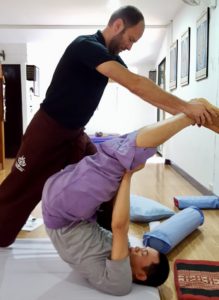
Greg Ryan Glass, LMT, is a licensed massage therapist, here in Ventura, with nearly two decades of experience in naturopathic health care. Glass studied at 15 different schools of natural medicine and the focus of his private practice is in Traditional Thai Massage.
Thai Massage (known as Nuad Phaen Boran in Thailand) is a therapeutic form of bodywork and yoga therapy that is a part of Traditional Thai Medicine that was developed over thousands of years ago. Credit is given to an Ayurvedic doctor named Jivaka Kumar Bhacca (who is believed to have been the Buddha’s physician). Dr. Jivaka is revered in Thailand as the “father of medicine” and therapists in Thailand offer prayers to Dr. Jivaka before starting any massage sessions.
Glass spent several months in Thailand receiving one-on-one training under several world-renowned teachers of Thai massage. As an Ayurvedic naturopath, Glass focuses on comprehensive wellness, working to heal the mind, body and spirit. He personalizes programs to fit each individual’s needs.
“Through all of my years of research and experience, I’ve found that every individual’s journey to health is unique,” said Glass. “Regardless of who they are –– their age, body type or flexibility –– my goal is to have them leave here feeling better than they came.”
Thai massage is truly an art and Thai massage therapists understand that the flowing transitions between positions and the state of mind of the therapist are as important as the techniques themselves. Thai massage is a deep, focused and meditative full body treatment. Also known as Thai-Yoga Massage, it includes therapeutic stretching, rhythmic deep tissue compression (using mostly palms, forearms, knees and feet) and acupressure. Additionally some practitioners like to incorporate essential oils, such as ylang ylang oil, although this is not always the case. It is often called “lazy man’s yoga” because the client is passive and completely supported in all positions by the therapist.
Thai Massage is done in 4 positions (supine, prone, side and seated) and fully clothed on a traditional Thai floor mattress. Usually the session starts with the client on their back (supine) with the practitioner starting at the feet, and spending a lot of time working on the clients legs and hips. Working with the legs, Thai therapists bring proper alignment and flexibility to the hip area, and indirectly to the spine. The condition of the spine is so crucial for ones health. In the west it is seen as the home of the central nervous system and in the Thai and Ayurvedic traditions it is the home of Sushumna Nadi and the 7 Chakras.
The most important aspect of Thai massage, is promoting the smooth flow of life force energy (known as prana or qi) through the 10 major energy channels known as the Sen Sib. As your muscles are massaged and stretched, this life force energy can flow freely where it was once stagnant or blocked. Holding tension in our bodies caused by physical and emotional stress constricts Prana.
The body, mind and emotions are all connected and affect one another. This is the essence of Thai Massage. These ten life energy paths (lines) are the heart of Thai massage and the basis of therapeutic Thai massage throughout the history of Thailand.
Sessions usually last 90 minutes to 3 hours and can be a profoundly relaxing and transformative experience for the client. Thai massage can help with stress, pain, range of motion limitations, poor circulation, respiratory problems, sleep issues, anxiety, immune system problems and adrenal burnout.
Traditional Thai Massage sessions are available in Ventura and done by Greg Ryan Glass, LMT at A Place of Peace Wellness Center on Sperry Ave. (831)331-7759, www.thaimassageventura.com
